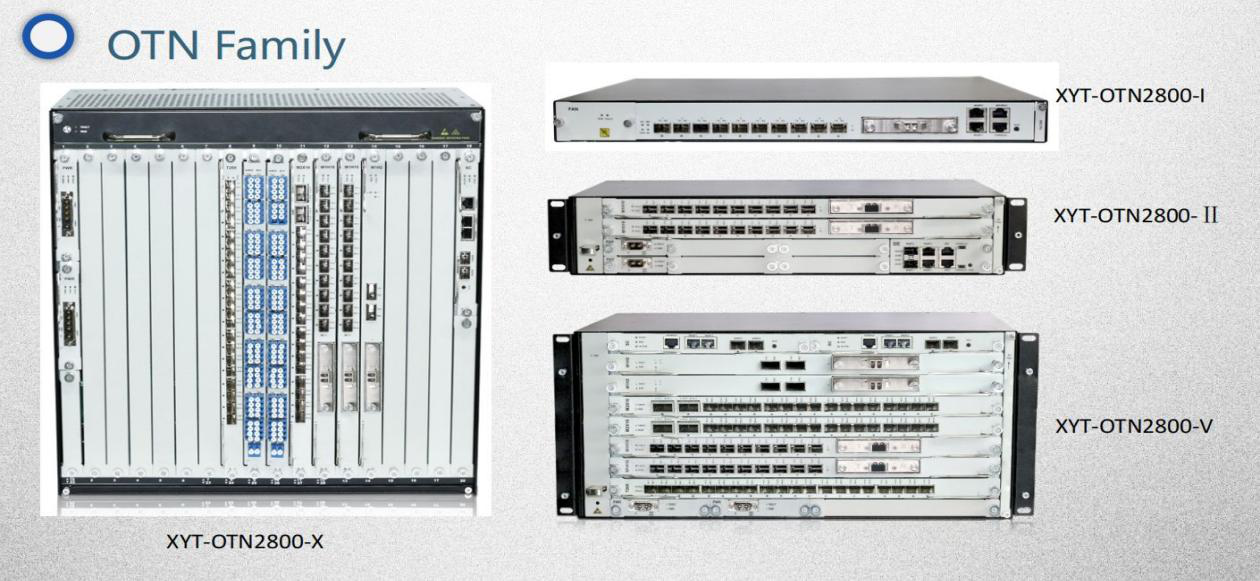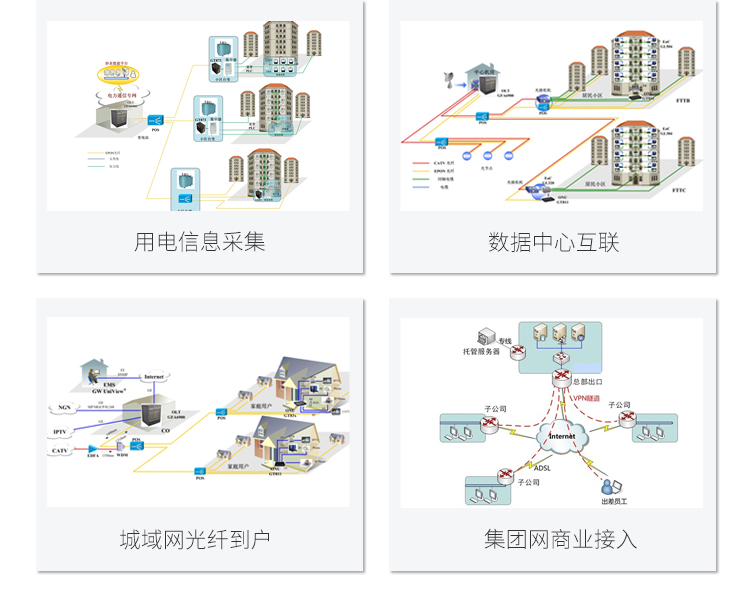
OTN (optical transport network) is a transmission network based on wavelength division multiplexing technology and organizing the network in the optical layer. It is the next generation backbone transmission network. In short, it is the next generation transmission network based on wavelength division.

BriefIntroduction
OTN is a transmission network based on wavelength division multiplexing technology and organized in the optical layer. It is the next generation backbone transmission network. OTN is a new generation of "digital transmission system" and "optical transmission system" standardized through a series of ITU-T recommendations such as g.872, G.709 andG.798, which will solve the problems of poor wavelength / sub wavelength service scheduling ability, weak networking ability and weak protection ability of traditional WDM networks. OTN solves a series of problems of traditional systems through a series of protocols.
OTN spans the traditional electrical domain (digital transmission) and optical domain (analog transmission). It is a unified standard for managing electrical domain and optical domain.
The basic object of OTN processing is wavelength level services, which advances the transmission network to the real multi wavelength optical network stage. Due to the combination of the advantages of optical domain and electrical domain processing, OTN can provide huge transmission capacity, completely transparent end-to-end wavelength / sub wavelength connection and carrier level protection. It is the best technology for transmitting broadband large particle services.
Main advantages
The main advantage of OTN is full backward compatibility. It can be based on the existing SONET / SDH management functions. It not only provides complete transparency of existing communication protocols, but also provides end-to-end connection and networking capabilities for WDM. It provides the specification of optical layer interconnection for ROADM and complements the sub wavelength convergence and grooming capabilities. It mainly establishes end-to-end link and networking capability based on SDH, and provides a model of optical layer.
OTN concept covers optical layer and electrical layer networks. Its technology inherits the dual advantages of SDH and WDM. The key technical features are as follows:
1.Multiple customer signal encapsulation and transparent transmission
The OTN frame structure based onITU-T G.709 can support the mapping and transparent transmission of a variety of customer signals, such as SDH, ATM, Ethernet, etc. Standard encapsulation and transparent transmission can be realized for SDH and ATM, but the support for Ethernet with different rates is different.ITU-T G.sup43 provides supplementary suggestions for different degrees of transparent transmission of 10GE services. For GE, 40GE, 100GE Ethernet, private network service fibre channel (FC) and access network service gigabit passive optical network (GPON), the standardized mapping mode to OTN frames is currently under discussion.
2. Bandwidth reuse, crossover and configuration of large particles
The electrical layer bandwidth particles defined by OTN are optical path data units (o-duk, k = 0,1,2,3), namely oduo (GE, 1000m / s), odu1 (2.5Gb / s), odu2 (10Gb / s) and odu3 (40Gb / s). The optical layer bandwidth particles are wavelengths. Compared with the scheduling particles of vc-12 / vc-4 of SDH, the OTN multiplexing, crossover and configuration particles are significantly larger, It can significantly improve the adaptability and transmission efficiency of high bandwidth data customer services.
3. Strong overhead and maintenance management capability
OTN provides overhead management capability similar to SDH. The OTN frame structure of OTN optical path (och) layer greatly enhances the digital monitoring capability of this layer. In addition, OTN also provides 6-layer nested series connection monitoring (TCM) function, which makes it possible to monitor the performance of OTN from end to end and multiple segments at the same time. It provides appropriate management means for cross operator transmission.
4. Enhanced networking and protection capabilities
Through the introduction of OTN frame structure, ODUk crossover and multi-dimensional reconfigurable optical add drop multiplexer (ROADM), the networking capacity of optical transmission network is greatly enhanced, and the current situation of providing high-capacity transmission bandwidth based on sdhvc-12 / vc-4 scheduling bandwidth and WDM point-to-point is changed. The adoption of forward error correction (FEC) technology significantly increases the transmission distance of the optical layer. In addition, OTN will provide more flexible service protection functions based on electrical layer and optical layer, such as photonic network connection protection (SNCP) and shared ring network protection based on ODUk layer, optical channel or multiplexing section protection based on optical layer, etc., but the shared ring network technology has not been standardized.
Differential connection
OTN and PTN
It should be said that OTN and PTN are completely different technologies. Technically, they have no connection.
OTN is an optical transmission network, which evolved from the traditional wavelength division technology. It mainly adds the intelligent optical switching function. It can realize optical crossover through data configuration without manual fiber hopping. It greatly improves the maintainability of WDM equipment and the flexibility of networking. At the same time, the new OTN network is gradually evolving to larger bandwidth, larger particles and stronger protection.
PTN is a packet transport network, which is the product of the integration of transport network and data network. The main protocol is tmpls, which has less IP layer and more overhead messages than network equipment. Ring networking and protection can be realized. It is a carrier level data network (the traditional data network can not meet the carrier level requirements). The transmission bandwidth of PTN is smaller than that of OTN. Generally, the maximum group bandwidth of PTN is 10G, the single wave bandwidth of OTN is 10G, the group bandwidth can reach 400G-1600G, and the latest technology can reach 40G. It is the backbone of the transmission network.
OTN and SDH, WDM
Based on WDM technology, OTN introduces SDH's powerful operation, maintenance, management and assignment (OAM) capability on the basis of super large transmission capacity, and makes up for SDH's lack of function and maintenance management overhead when facing the transmission layer. OTN uses embedded standard FEC with rich maintenance and management overhead. It is suitable for large particle service access FEC error correction coding, improves bit error performance and increases the span of optical transmission.
Application scenario
The intelligent optical network based on OTN will provide a very ideal solution for the transmission of large particle broadband services. The transmission network is mainly composed of inter provincial trunk transmission network, intra provincial trunk transmission network and metropolitan (local) transmission network, and the metropolitan (local) transmission network can be further divided into core layer, aggregation layer and access layer. Compared with SDH, the biggest advantage of OTN technology is to provide scheduling and transmission of large particle bandwidth. Therefore, whether OTN technology is adopted at different network levels depends on the size of the main scheduling service bandwidth particles. According to the current network situation, the main particles of core layer scheduling of inter provincial trunk transmission network, intra provincial trunk transmission network and metropolitan (local) transmission network are generally GB / s or above. Therefore, OTN technology with better advantages and scalability can be preferentially used at these levels. For the convergence and access level of metropolitan (local) transmission network, when the main scheduling particles reach the GB / s level, OTN technology can also be used preferentially.

1. National trunk optical transmission network
With the IP of network and services, the development of new services and the rapid increase of broadband users, the IP traffic on national trunk lines has increased sharply, and the bandwidth demand has doubled year by year. WDM national trunk line carries PSTN / 2G long-distance service, NGN / 3G long-distance service, Internet national trunk line service, etc. Due to the huge carrying traffic, the protection demand of wave division national trunk line for carrying traffic is very urgent.
After adopting OTN technology, the bearing mode of national trunk IP over OTN can realize SNCP protection, ring network protection similar to SDH, mesh network protection and other network protection modes. Its protection capacity is equivalent to SDH, and the equipment complexity and cost are greatly reduced.
2.Provincial / regional trunk optical transmission network
Backbone routers in the province / region carry services between long-distance bureaus (NGN / 3G / IPTV / key customer dedicated lines, etc.). Through the construction of OTN optical transmission network of provincial / regional trunk lines, the safe and reliable transmission of Ge / 10GE and 2.5g/10gpos large particle services can be realized; Can form ring network, complex ring network and mesh network; The network can be expanded on demand; It can realize cross scheduling and grooming of wavelength / sub wavelength services, and provide wavelength / sub wavelength long customer dedicated line services; It can also realize the transmission of other services, such as STM-1 / 4 / 16 / 64sdh, ATM, Fe, DVB, HDTV, any, etc.
3. Metro / local optical transmission network
At the core layer of man, OTN optical transmission network can realize the transmission of large particle broadband services between man Convergence Router, local network C4 (district / County Center) Convergence Router and man core router. The uplink interface of the router is mainly Ge / 10GE or 2.5g/10gpos. OTN optical transmission network in metro core layer can not only realize the transmission of large particle telecommunications services such as Ge / 10GE, 2.5g/10g/40gpos, but also access other broadband services, such as STM-0 / 1 / 4 / 16 / 64sdh, ATM, Fe, ESCON, FICON, FC, DVB, HDTV, any, etc; For Ethernet services, layer-2 aggregation can be realized to improve the bandwidth utilization of Ethernet channel; It can dredge the wavelength / sub wavelength services and realize the access of wavelength / sub wavelength dedicated line services; It can realize bandwidth on demand, optical virtual private network, etc., so as to realize bandwidth operation. From the perspective of group network, it can also reorganize the network structure of complex metropolitan transmission network to make the level of transmission network more clear.
4. Construction of proprietary network
With the increase of the application demand of enterprise network, large enterprises and government departments also have the demand for large particle circuit scheduling, while the private network is very poor compared with the operator's network optical fiber resources. The introduction of OTN not only increases the scheduling flexibility of large particle circuit, but also saves a lot of optical fiber resources.
In the man access layer, with the downward movement of broadband access equipment, DSLAM access equipment such as ADSL2 + / VDSL2 will be widely used, and Ge uplink will be adopted; With the increasing number of Ge dedicated line users of the group, the number of Ge interfaces will also increase significantly. The distance between ADSL2 + equipment and the user is 500 ~ 1000m, and the distance between VDSL2 equipment and the user is within 500m. A large number of Ge services need to be transmitted to the bas and SR of the end office. The combination of OTN or OTN + OCDMA-PON is a better choice, which will greatly save the rapid consumption of optical fiber resources caused by optical fiber direct connection. At the same time, OTN can be used to protect services and enhance the manageability and operability of bandwidth resources in the access layer of metropolitan area network.
Development trend
OTN is a new technology for application, but its own development has a history of many years and has become mature. ITU-T started the formulation of OTN series standards in 1998. By 2003, the main standards have been basically improved, such as OTN logic interface G.709, OTN physical interface g.959.1, equipment standard g.798, jitter standard g.8251, protection switching standard g.873.1, etc. In addition, ITU-T has also completed the formulation of corresponding main specifications for OTN based control plane and management plane.
In addition to the improvement of standards, OTN technology has also made rapid progress in equipment and test instruments in recent years. Mainstream transport equipment providers generally support one or more types of OTN devices. In addition, mainstream transmission instrument providers can generally provide instruments supporting OTN function.
With the strong driving of the rapid development of business and the increasing maturity of OTN technology and implementation, OTN technology has been partially applied to experimental or commercial networks. In the United States and Europe, large network operators such as Verizon and Deutsche Telekom have established G.709 OTN network as a new generation transmission platform. It is expected that OTN will usher in large-scale development in the next few years.
Foreign operators have generally put forward obvious requirements for the support ability of OTN interface of transmission network, while the actual network applications are mainly in the form of ROADM equipment, which is closely related to factors such as network management and maintenance cost and networking scale. Domestic operators are also quite concerned about the development and application of OTN technology. Since 2007, China Telecom, the former China Netcom and China Mobile Group have carried out application research and test verification of OTN technology. In addition, some provincial networks have also locally deployed transmission test networks based on OTN technology, and the networking nodes have OTN devices based on electric layer crossing, There are also ROADM based OTN devices. Since the maintenance cost of ROADM is relatively high compared with the current maintenance system, ROADM has only been used in a small range of experiments in some operators, and OTN equipment based on electric layer crossing has been widely used in major operators such as China Mobile, telecom, China Unicom, radio and television, as well as large private networks such as southern power and Sinopec.
As the best choice for the development of transmission network technology, it can be expected that in the near future, OTN technology will be more widely used and become the preferred technology for operators to create excellent network platform and expand business market.
